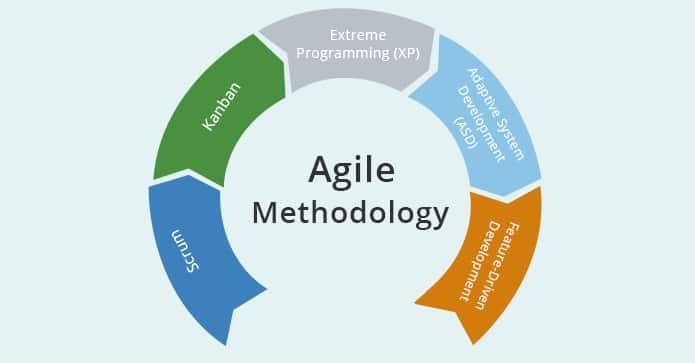Agile software development for business (Part-1)

Author : TechAffinity 2nd Mar 2023

Businesses must find methods to stay competitive as technology develops, and many choose agile software development as one solution. Agile software development is a methodology that prioritises client satisfaction, cooperation, flexibility, and speed. It’s an iterative process that enables the quick release of high-calibre software. We’ll go over the top five justifications for organisations choosing agile software development in this blog post. We’ll examine how agile software development can result in more rapid outcomes, lower costs, higher levels of customer satisfaction, and more.
Agile methodology

The Agile software development technique is based on sprints, which are time-boxed project cycles. During a sprint, a team works on a predetermined number of features known as “user stories” for a brief amount of time—typically two weeks. The crew can complete these tales within two weeks. As a result, compared to a waterfall project, the sprint has a substantially fewer number of features. This method of feature restriction makes the product development and release cycle more manageable.
A traditional project team is substantially larger than an agile team, which should have no more than 12 members. The project manager, also known as the Scrum master, the product owner, analysts, developers, and QA testers make up the team. Throughout each sprint, the team can reach out to the product owner for assistance and feedback as they represent the interests of the project’s stakeholders. The team engages in daily stand-up meetings during a sprint to discuss progress. The team does a formal release at the end of the sprint before starting a planning session for the following sprint.
Reasons why organisations choose Agile software development
Agile software development for business has measurable and obvious primary advantages. They consist of things like increased developer efficiency, flexible planning, better code quality, and fewer conflicts during integration and deployment.
Success in agile software development for businesses is determined by the level of client satisfaction with the finished product and by the stage of development that the project is in. This means that achieving or exceeding expectations does not occur as a result of reaching milestones or business goals. They take place because agile development allows you to demonstrate the stakeholders incremental results every few weeks during sprint review meetings or sprint planning, where they can approve new features based on what they have seen thus far and anticipate the next sprint.
1. Continuous learning and feedback
In agility, teams and businesses frequently interact with one another so that everyone may learn from one another. Continuous feedback loops ensure that errors are quickly corrected and that the plan is modified in response to feedback. In this procedure, continuous supply is undoubtedly beneficial.
With fewer chances of producing low-quality outputs, teams can be more productive and frequently produce more value on schedule and under budget. Agile teams are capable of swift learning and adaptation, taking management feedback into account as they go.
2. Low risk
Agile methods boost productivity while lowering risk; they also reduce faults; they ensure customer satisfaction through continuous deployment; they satisfy interested parties by releasing public versions frequently; and they promote sustainable development, which creates resilient ecosystems.
Customer feedback is crucial in agile software development in determining if new features should be published or not, but in waterfall software development there is far more risk because it is very difficult to stop or change a phase once it has begun.
The finished result is supplied early and frequently in agile software development, allowing for constant input so that problems can be corrected as they arise. Large portions of work must be altered in waterfall projects since a significant portion of the work is finished before any client input is obtained.
Agile makes it possible to make modifications as you go along rather than waiting until everything is finished before realising, you’re missing anything. Management develops more faith in agile procedures by witnessing their input adopted early on.
Agile software development projects have shorter planning time and reduced risk, which allows for more opportunities to make changes in response to client needs without adding to expenses. This can result in greater software quality products.
3. Product excellence and consumer satisfaction
In order to ensure that solutions are provided fast and satisfy customer expectations, agile software development places a strong emphasis on collaboration between software engineers, customers, and other stakeholders. Because iterative development fosters regular input, problems can be swiftly identified and fixed. In the end, it leads to better products and more satisfied customers. Additionally, agile software development allows for speedy adaptation to satisfy client needs even in situations when requirements are unknown or changing quickly.
4. Reduce complexity
One advantage of agile development is that it aids in the reduction of complexity in the software development life cycle. It is not necessary for the core programming team to write, test, and maintain everything at once. Instead, smaller teams iteratively work on several project components simultaneously, completing their own job and then handing it off to another team (or looping back around to fix any problems found).
People are thus given the freedom to learn independently and are encouraged to make mistakes. It also exhorts business owners, product designers, and developers to embrace change without holding back out of a desire to appease everyone. Finally, it clarifies what you truly get for your time and money when working on the product backlog.
Agile software development projects are decentralised, so instead of completing the task all at once, you can share it out across several teams working concurrently. Early feedback enables the delivery of higher-quality products, which can increase customer satisfaction.
5. Increased visibility and pertinent metrics
Enterprises benefit from agile software development because it allows them to adapt to changes and have a better grasp of how their projects are progressing more simply and quickly. Agile software development enables teams to analyse the quality and efficacy of their work, track progress over time, and pinpoint areas for improvement. The effectiveness of the team can be evaluated using metrics like velocity, lead time, and cycle time, and the development of the project can be tracked using burn-down and burn-up charts. Enterprises may quickly and easily change plans, prioritise tasks, and make adjustments as necessary to fulfil deadlines by using these KPIs.
Conclusion
Enterprise-level companies now prefer agile software development, and for good reason. It promotes consumer happiness, is flexible and scalable, and offers a base for creativity. Enterprises need to be ready to adapt as the world of technology changes, and agile software solutions give them the framework and tools to achieve that. Agile software development is ultimately a cost-effective and effective strategy for businesses to maintain their competitiveness in the constantly shifting technology landscape.
At TechAffinity, we ensure all your web development, software development, and mobile application development needs are taken care of from end-to-end. We do not limit ourselves only up to deploying your apps, but also take care of marketing your product on digital platforms. Feel free to share your project ideas with our experts by sending an email to media@techaffinity.com or schedule a meeting with us.